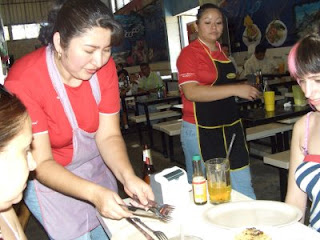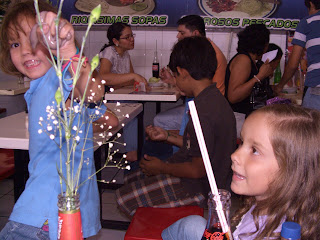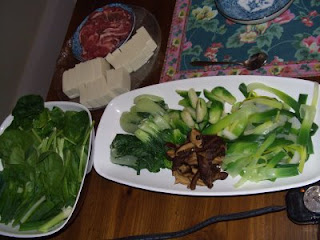.
.
.
.
.
.
I also see that friends in Spain are reading my blog - so leave comments if you have any questions about life here.
.
.
.
.
.
.
So I will finally turn to the local food or comida típica. I think I have delayed this because, while I really enjoy it, I don’t know it very well yet.
.
.
.
.
.
.
The most traditional food here is the pupusa - a corn or rice flour thick tortilla that is stuffed with cheese, chicharrones, and beans. It is made by making a masa or dough with the right amount of water because consistency is very important. Then you take a ball of dough, make a hole inside, put the filling in, fold the top closed and pat it out between your hands - no press or machine can do it as well. Oh, you can put a bit of oil on your palms so it doesn’t stick. Then fry it up and eat it with cortida (which is a vinegary cole slaw made with hand cut cabbage, carrots, sometimes onions and jalapenos, and oregano) and a water tomato sauce. Oddly, this national meal is also slang for a woman’s private parts because the patting together of the hands while forming the pupusa reminds some people of Lesbians getting it on. Excuse the vulgar anecdote here.
Our second starter at Maurita's - Chicharrones with fried tortillas and pico de gallo (the salsa like stuff)
.
.
.
.
.
.
.
This food is popular with all Salvadorans although some of my gringo friends hate them and claim that you will always get sick from eating them and that the pork is rancid. I have eaten them from maybe 10 different places/stands and never had a problem. On the Travel Channel, I saw a show where both Anthony Bourdain and Andrew Zimmern ate pupusas in NYC and they were both familiar with them and love them ... so that’s great food cred right there.
Fatima's separate and stuff technique
.
.
.
.
.
.
.
I think that Fatima has the best way of eating them. She separates the two halves and then eats them like two soft tacos with the cortida on the inside. We all love them in the house but don’t eat them very often since they are very fattening and very condusive to turning regularly proportioned people into very round people.
.
.
.
.
.
.
What I find really maddening is that pupusas can only be found for breakfast or dinner - and I think it is the perfect lunch food! I have heard various explanations for this - that it was supposed to be a big filling breakfast that workers would have at home before heading out to the fields to work all day. And the opposite where the workers have such a big lunch with meat, rice, beans, salad, tortillas or bread that they only want something small like a pupusa at the end of the day. Whatever the reason, this is harsh fact of life in El Salvador - although we were able to get pupusas for lunch one day when Elliot and his two friends were visiting from Canada.
.
.
.
.
.
.
We were at my favourite comida típica place, the Mercado de Antiguo Cuscutlan, looking for a food stand that had pupusas. A lot of the big flat top grills were making tortillas but all the fixings for pupusas were put away. I offered women $5 tips to make a few pupusas ... and was turned down at 5 different places.
Fresh oysters on the half shell at Maurita's
.
.
.
.
.
.
.
We ended up at Mauritas where I explained the problem to a waitress and she said hold on ... and came back saying she found someone who would commit the social outrage of cooking pupusas for lunch but we had to pay a 10 cent premium on each one and we had to order 20 of them ... done ... and enjoyed!
My favourite ... Sopa de Patas
.
.
.
.
.
.
.
So that is how we came to become loyal to Mauritas. There are probably about 40 food stands and we have eaten at maybe 8 of them. Many of them are very quiet and empty but Mauritas is probably the biggest and busiests (and they take credit cards). They have fresh oysters (for $8, $10 and $12 per dozen, depending on the size), black clams that my friend Minh says are like the kind they had in Viet Nam, and all the traditional meals. We always start with a fresh soft cheese, avocados, and chicharrones (which is actually the name of a fried pork rind but is made here with big chunks of pork meat fried in pork fat), with fresh and fried tortillas.
Sopa de Mariscada

.
.
.
.
.
.
The the girls usually have a big seviche and I will have a big bowl of Sopa de Patas - a very hearty soup made with cow’s feet and served with big pieces of tendon, tripe, and big chunky vegetables like corn on the cob, cabbage, yucca, wiskil, and carrot. It is served with chopped onion and cilantro and I cover it in hot sauce.
Counting the empties to get a free Pilsener key chain ... sweet!
.
.
.
.
.
.
.
Yum! Usually have 3-4 beers provided by the lovely Constancia and Brava beer girls who are constantly fighting for our patronage - Constancia has skinnier girls who offer little gifts like glasses and beer openers while the Brava girls are larger and bustier women who offer a free beer after having 6.
.
.
.
.
.
.
The other great traditional soup is Mariscada which is a rich seafood soup made with fish, shrimps, langostine, and crab. Maybe some clams too? Then they pour heavy cream into it when they serve it (which is optional - you can have the healthy version which has more veggies in it at some places). Very delicious, rich, and messy if you take the small crab apart.
You can also get really fresh seafood - it goes from the fishmongers into the frying pan here. I tried a turtle egg once ... I know, a protected species but very popular here. It was put into boiling water for maybe 30 seconds and served to me ... it had a soft and leathery shell, you make a hole in the top, put in salt (maybe lime or hot sauce as well), then you suck out the liquidy mess ... did not enjoy that at all.
You can also get really fresh seafood - it goes from the fishmongers into the frying pan here. I tried a turtle egg once ... I know, a protected species but very popular here. It was put into boiling water for maybe 30 seconds and served to me ... it had a soft and leathery shell, you make a hole in the top, put in salt (maybe lime or hot sauce as well), then you suck out the liquidy mess ... did not enjoy that at all.
Reminds me of the Sopa de Garrobo that I had once at another restaurant. An iguana soup where the reptile was first boiled to make a broth and then the carcass was fried and served as meat ... the broth was bitterish and quite unpleasant while the animal was extremely bony and had virtually no meat on it. Wow, not good. BUT, I was at a gastronomical food fair where 300 Salvadoran chefs set up at the Sheraton’s big ballroom and the best thing I tried was a Sopa de Garrobo ... rich, deep, delicious ... and am kicking myself for not finding out where that chef worked.
.
Lots of fresh fruits and vegetables
 .
.
.
.
.
.
.
.
.
.
.
.
.
.
.
.
Lots of fresh fruits and vegetables
 .
..
.
.
.
.
.
.
.
.
.
.
.
.
So we like to meet friends at the Mercado and we have a big weekend brunch meal. It has been getting a lot more crowded on Saturdays since Sky TV in Mexico took over the rights to broadcast Spanish Football in Central America. So the thousands of fans of Barcelona and Real Madrid have to go somewhere that has a satellite feed to watch their beloved team ... which makes the Market a popular place with TVs at every food stand. Afterwards, we go to the DVD stand and I buy a bunch of bootlegs to bring to Cuba and we go buy vegetables. The Mercado also has a shoe repair place, shoe stores, hair salons, a florist, stationary shop, and an artesanal goods shop. If you make it down to visit, I'll have to take you to this place.
Cooking pots and corn grinders made from volcanic rock
If you make it down to visit, I'll have to take you to this place.
























